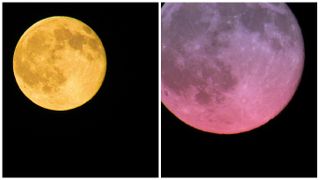Delicious 'Strawberry Moon' Photos: Rare Solstice Lunar Show Wows Stargazers

June's full moon — known in some cultures as a "Strawberry Moon" — greeted night sky watchers yesterday (June 20), and coincidentally fell on the summer solstice, the longest day of the year.
Space.com received a flood of gorgeous photographs of this celestial sight from readers all over the world. It was apparently a very popular event; even an astronaut on the space station couldn't resist taking a snapshot of Earth's neighbor.
The so-called "Strawberry Moon" may have gotten its name from Native American tribes because it arrives in June, when strawberry season is at its peak. But when the moon is close to the horizon, it also takes on a reddish tint, and in Europe, the June full moon is sometimes known as the "Rose Moon." [See More Reader Photos of the 'Strawberry Full Moon']
The composite photograph at the top of this article, captured by photographer Grant Johnson, shows how the color of the moon changes as it moves away from the horizon.
"I caught this stack of shots from tonight's solstice moonrise on Duluth, Minnesota's Park Point beach on Lake Superior," Johnson told Space.com in an email. "I zoomed in on the Superior Entry Lighthouse with a 250mm lens from about 2 miles [3.2 kilometers] away to get the Strawberry Moon to rise large above the lighthouse."

A full moon hasn't appeared on the summer solstice since 1948. The romantic juxtaposition of a bright, colorful moon and the beginning of summer was perhaps best captured in the photo above, taken by sky photographer Jeff Berkes (whose super-awesome photos have been featured on Space.com many times). The image, taken in southern Pennsylvania, uses focus stacking to get the interesting view of both the moon in the background and the flowers in the foreground, Berkes told Space.com in an email. He said that he doesn't typically use this technique, but "I thought it [might] come out pretty neat." The final image is two shots combined, and was snapped with a Nikon D4 with 200mm lens.
Get the Space.com Newsletter
Breaking space news, the latest updates on rocket launches, skywatching events and more!

A Strawberry Moon themed animation (above) even appeared on Google's front page as a Google Doodle.

Light passing through Earth's atmosphere can make the moon look as if it has a colorful tint. This effect is especially visible during a lunar eclipse. The above photos, taken by Nate Laurant, exaggerate the colored tint of Monday's full moon.

The above image may not be colorful, but the level of detail captured by sky photographer Giuseppe Petricca is absolutely breathtaking. Petricca, who lives in Italy, told Space.com the image is a mosaic composed of 30 panels. The images were taken using a SkyWatcher Black Diamond Newton 200/1000 telescope.

Astronaut Jeff Williams took the above image of the full moon from the International Space Station, "just before sunset while flying over western China," according to his post on Facebook.
Summer has just begun, and it's already a cosmic season. Check out our suggestions for how to bring even more space into your summer season.
Follow Calla Cofield @callacofield.Follow us @Spacedotcom, Facebook and Google+. Original article on Space.com.
Join our Space Forums to keep talking space on the latest missions, night sky and more! And if you have a news tip, correction or comment, let us know at: community@space.com.

Calla Cofield joined Space.com's crew in October 2014. She enjoys writing about black holes, exploding stars, ripples in space-time, science in comic books, and all the mysteries of the cosmos. Prior to joining Space.com Calla worked as a freelance writer, with her work appearing in APS News, Symmetry magazine, Scientific American, Nature News, Physics World, and others. From 2010 to 2014 she was a producer for The Physics Central Podcast. Previously, Calla worked at the American Museum of Natural History in New York City (hands down the best office building ever) and SLAC National Accelerator Laboratory in California. Calla studied physics at the University of Massachusetts, Amherst and is originally from Sandy, Utah. In 2018, Calla left Space.com to join NASA's Jet Propulsion Laboratory media team where she oversees astronomy, physics, exoplanets and the Cold Atom Lab mission. She has been underground at three of the largest particle accelerators in the world and would really like to know what the heck dark matter is. Contact Calla via: E-Mail – Twitter
Most Popular


